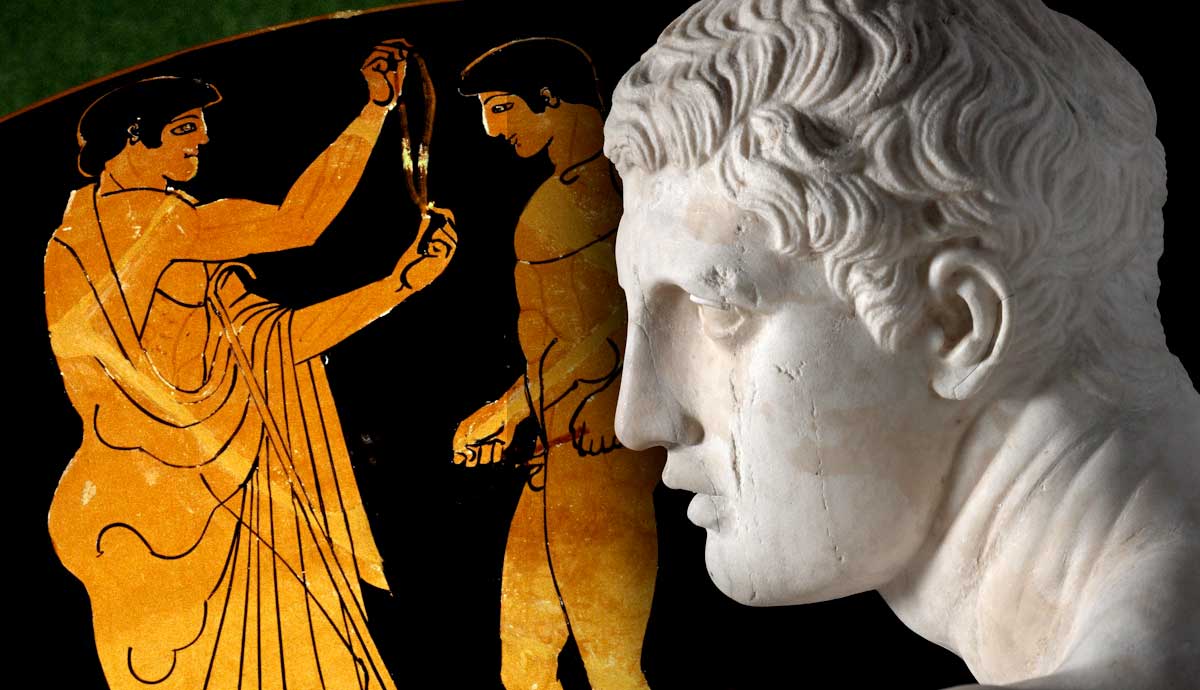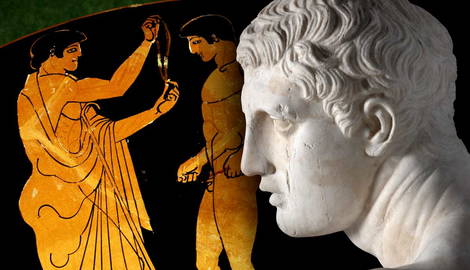
summary
- The Panhellenic Games of ancient Greece were athletic and cultural competitions held at four major sanctuaries across the Greek world. These games were the Olympic, Pythian, Nemean, and Isthmian.
- Olympic Games: originated in 776 BCE at Olympia, were devoted to Zeus and featured events from foot races to combat sports. Victors were honored with wreaths made from the sacred wild olive.
- Delphi’s Pythian Games: established in 586 BCE, were devoted to Apollo. Among others, they included horse races and musical competitions. The winners were honored with laurel wreaths.
- Isthmian Games: held biennially, celebrated Poseidon, with crowns of pine offered to the winners.
- Nemean Games: held biennially, celebrated Zeus, with crowns of wild celery offered to the winners.
The Panhellenic Games were a series of athletic competitions that brought together athletes and spectators from all over the ancient Greek world. The first Games were organized in Olympia in 776 BCE. Three other Games, which imitated the original, popular Olympics, also gained Panhellenic status. Here is everything you need to know about the four Panhellenic Games: the Olympic Games, the Pythian Games, the Nemean Games, and the Isthmian Games.
1. The Olympic Games at Olympia: The Original

There are different theories on why the Olympic Games were born. The athletic competitions were likely an extension of festivals around cult rituals and practice for hunting skills. The athletic competitions had tight connections to religious festivals and were always held at locations of important sanctuaries. The temple in Olympia was initially small. However, already in the 9th century BCE, it was well known throughout the Peloponnese and central Greece as a place to worship the god Zeus.
The first Olympic Games were organized in Olympia in 776 BCE, and since then, approximately every four years. The first 13 Games had only one event, a running competition. But as the Panhellenic Games became more established, the audience began demanding new and exciting spectacles, and, consequently, new events were added regularly.
With no organized facilities, the conditions for the audience in Olympia were famously unbearable. Yet the possibility of watching the most skillful and beautiful among the Greek youth competing in races, throwing events, and heavy contests such as boxing and wrestling made the trip worthwhile. The winners at the Olympic Games received a wreath made of wild olive trees.
2. The Pythian Games in Delphi: The Oracle & the Athlete

The Pythian Games were held in Delphi, a place famous for its Oracle. The sanctuary dedicated to Apollo became gradually more important both religiously and politically in the 6th century BCE. The first Pythian Games were organized in 586 BCE, and since then, approximately every four years, just like the Olympics. Like all Panhellenic Games, the Pythian Games were intertwined with religious ceremonies. The spectators could participate in celebratory processions and offer sacrifices to the god. In the first games, the prizes were loot from war, but since 582 BCE, the victors were crowned with a laurel wreath.
Delphi was one of the richest temples in ancient Greece. It was politically important, so the various social events that accompanied the games were equally important for many visitors. Delphi was, after all, the “omphalos”, the navel of the earth, and the place where the famous Oracle could be consulted on political and personal matters.
The events in all Panhellenic Games were virtually identical because they were created to imitate the original Olympic Games. However, at the Pythian Games, there seems to have been a particular emphasis on horse races. Many famous Greek rulers participated in these races and, unsurprisingly, won. A few magnificent surviving sculptures from the Classical period are dedicated to the chariot winners.
Visitors of Delphi can today admire the stadium in the form in which Herodes Atticus elevated it in the 2nd century CE. The Hippodrome, however, where the horse races took places, was only excavated quite recently. It is located about 1 km or 0,6 miles from the sanctuary.
3. The Isthmian Games in Corinth: Competing for Poseidon

The ancient Isthmian Games were held at the temple of Poseidon in Isthmia, close to the city of Corinth. Corinth was an important site in antiquity, strategically positioned in the narrow stretch of land that connects the Peloponnese with mainland Greece. The location made the Isthmian Games easily accessible to Greeks from all over the Mediterranean world. Corinth was basically the gateway to the Peloponnese, making it a very important hub for trade and culture.
The first temple of Poseidon in Isthmia was built in the 7th century BCE. The first Games are documented in 582 BCE and were since organized every two years. Whereas the Olympics and the Pythian Games took place every four years, the Isthmian Games and the Nemean Games were arranged in a two-year cycle. This allowed the Greeks to participate in at least one event every single year. Along with the athletic events, such as foot races, wrestling, boxing, and pankration, the Isthmian Games included competitions in music and poetry. Winners were crowned with wreaths made of pine trees.
4. The Nemean Games: Honoring Zeus

The first Nemean Games were organized in 573 BCE. After the Peloponnesian War, Nemea was destroyed and subsequently abandoned for about 75 years. From 340-330 BCE, the Games were revived and, since then, held every two years until 271 BCE when they were moved from Nemea to Argos where they continued taking place. The Nemean Games were part of a religious festival held in honor of the god Zeus. Like other Panhellenic Games, the Nemean Games included foot races, heavy competitions, and musical and poetic contests. The winners were awarded wreaths made of wild celery.
The Nemean Games were held in the valley of Nemea, surrounded by mountains and thick forests. Nemea’s location, far from urban centers, made it seem like a neutral place. The Nemean Games included similar events to other Panhellenic Games, but there seems not to have been an emphasis on the horse races. Musical competitions were also added to the Game program, but later than in other Panhellenic Games. The specialty of the Nemean Games was that the athletes were divided based on age into the following three groups: children from 6 to 12-year-olds, beardless youth from 16 to 20, and men above the age of 20. Nemea had many facilities for athletes and even a mechanical starting system for the runners.
The Nemean Games have made a comeback in modern times. Anyone can now participate in the running competition — that is if they want to try running barefoot, wearing a chiton, under the scorching Greek sun. The next opportunity is in 2024.
Why Were There Only Four Panhellenic Games?

Hundreds of other local festivals and games were held throughout Greece, but the four Panhellenic Games were the most prestigious. They were recognized by all the city-states and were open to athletes from all over the Greek world.
Many have heard about the Panathenaia, the extravagant festival of Athens. The Panathenaia was held every four years and included the same athletic events as all of the Panhellenic Games. Founded in 566 or 565 BCE, the Panathenaia was held in honor of the city’s patron goddess, Athena. Panathenaia continued until 410 CE, longer than the original Olympics. Yet it is not considered a Panhellenic Game, as the spirit was local, and the emphasis was placed on celebrating equally the athletic, cultural, and intellectual skills of the Athenian youth.
Another noteworthy local competition was held in the city of Larissa in Thessaly, Greece. This politically significant city organized its own games since at least the second half of the 5th century BCE. The events at Larissa were inventive, and there were also bull riding and bullfighting competitions. Later, the Romans took inspiration from the bullfighting of Larissa, and from Rome, the practice spread to other countries such as Spain.
What Ended the Panhellenic Games?

The Roman emperor Theodosius, a devout Christian, holds the historic honor of being the person who officially ended the Panhellenic Games. The ban was imposed first in 393 CE, but his successor Theodosius II had to renew it, so it seems that the games did not end abruptly in all cities. The final straw came in 520 CE with a decree by Justin I, which closed the philosophical schools in Athens and finally ended all pagan activities in Greece. Christianity had already become the Roman Empire’s official state religion by Theodosius.
Although the Panhellenic Games were celebrations of Greek culture, the games were essentially organized in honor of the Olympian gods. From the perspective of advancing the Christian faith, the Games were, in a sense, pagan, so they had to be stopped.
An earthquake shook Olympia in the 6th century CE and lead to its abandonment. At Delphi, the pagan activity stopped, but a Christian community continued living there. Isthmia was abandoned with the prohibition of the old religion. A Christian community settled in Nemea in the 4th century CE.
A List of Events at the Panhellenic Games

The Panhellenic Games brought the Greeks together. For the duration of the Games, the city-states maintained a sacred truce. This guaranteed safe travel for all participants and spectators joining the festivals. Although the ideal was about unity, there were no team sports at Panhellenic Games. Instead, the games were about the power and heroism of the male individual.

The events and rules of the games varied over time and across different locations. Additionally, not all athletic events were held at every game, and some events were added or removed over the centuries.
Events of the Four Panhellenic Games of Ancient Greece
1. Olympic Games:
– Running races, including the stadion (a sprint of approximately 200 meters), diaulos (approximately 400 meters), and dolichos (ranging from 1,400 to 4,800 meters).
– Combat sports, including boxing, wrestling, and pankration (a form of free fighting).
– Equestrian events, including horse racing and chariot racing.
– Pentathlon, a combination of running, long-jump, discus, javelin, and wrestling.
– A race in full hoplite armor.
2. Pythian Games:
– Running races, including the stadion, diaulos, and dolichos.
– Combat sports, including boxing, wrestling, and pankration.
– Equestrian events, including horse racing and chariot racing.
– Music and poetry competitions.
3. Nemean Games:
– Evidence of the events at Nemea is scarce, but the events likely included the running races, including the stadion, diaulos, and dolichos.
– Combat sports, including boxing and wrestling.
– Equestrian events, including four-horse-chariot racing and one-horse race.
– Music and poetry competitions, famously kithara and flute-playing.
4. Isthmian Games:
– Running races, including the stadion, diaulos, and dolichos
– Combat sports, including boxing and wrestling
– Equestrian events, including horse racing and chariot racing
– Music and poetry competitions
– Pentathlon, a combination of running, long-jump, discus, javelin, and wrestling.
FAQs
What role did women play in the Panhellenic Games?
Women were largely excluded from participating in the main events of the Panhellenic Games, with the notable exception of the Heraean Games, a women’s athletic competition held in Olympia in honor of Hera. However, they could own chariots in equestrian events, winning indirectly.
What was the economic impact of the Panhellenic Games?
The Panhellenic Games significantly boosted local economies through increased trade, tourism, and infrastructure development. They attracted visitors from across the Greek world, fostering economic activity and promoting cultural exchange and craftsmanship.
How does the modern revival of the Nemean Games differ from the ancient version?
The modern revival of the Nemean Games emphasizes inclusivity and cultural appreciation over competition. Unlike the ancient version, which was exclusively for male athletes and had religious significance, the revived games welcome participants of all ages and genders to compete in traditional events, wearing tunics, aiming to experience ancient Greek culture rather than achieve athletic glory.










